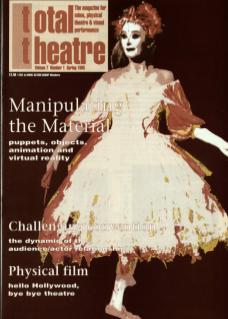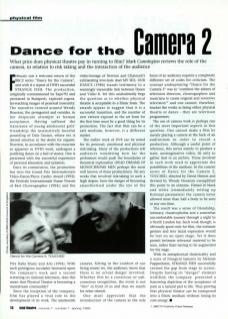February saw a welcome return of the BBC2 series Dance for the Camera, and with it a repeat of DV8's successful Strange Fish. The production (originally commissioned by Expo'92 and premiered in Budapest), explored cogent, far-reaching images of personal insecurity. The narrative centred around Wendy Houstoun, the protagonist and outsider, in her desperate attempts at human acceptance. Having suffered the transience of young adolescent girls' friendship, and the insensitively forceful pounding of Dale Tanner, where sex is denied emotion in the desire for orgasm, Houstoun, in accordance with the exorcism so apparent in DV8's work, undergoes a purifying dance on a bed of stones. One is presented with the sorrowful experience of personal alienation and isolation.
Since its commission, the production has won the Grand Prix Internationale Video-Danse / Pierre Cardin Award (1993); the Festivale Internationale Danse Visions of Best Choreographer (1994); and the Prix Italia Music and Arts (1994). With such prestigious accolades bestowed upon the company's work and a second screening on national television, does this mean that Physical Theatre is becoming a mainstream commodity?
Since the inception of the company, film has played a vital role in the development of its work. The amateurish video-footage of Newson and Charnock's exhilarating love-hate duet My Sex, Our Dance (1986) stands testimony to a seemingly inexorable link between Dance and Video. Yet this undoubtedly begs the question as to whether physical theatre is acceptable in a filmic form. The awards appear to suggest that it is a successful transition, and the number of new viewers exposed to the artform for the first time must be a good thing for its promotion. The fact that film can be a safe medium, however, is a different matter.
The earlier work of DV8 can be noted for its personal, emotional and physical risk-taking. Many of the productions left audiences wondering how far the performers would push the boundaries of theatrical exploration (Dead Dreams of Monochrome Men being perhaps the most well known of these productions). Yet any works that involved risk-taking to such a high degree, have the danger of becoming anaesthetised under the eye of the camera. Sitting in the comfort of our living rooms we, the audience, know that there is no actual danger involved. Whether this be a conscious or subconscious recognition, the event is not ‘live’ in front of us and thus we search for other stimuli.
One must appreciate that the introduction of the camera as the sole focus of an audience requires a completely different set of codes for criticism. The concept underpinning ‘Dance for the Camera 2’ was to ‘combine the talents of television directors, choreographers and musicians to create original and inventive television’ and one cannot, therefore, bracket the works as being either physical theatre or dance – they are television programmes.
The use of camera work is perhaps one of the most important aspects in this question. One cannot make a film by merely placing a camera at the back of an auditorium in order to record a production. Although a useful point of reference, this serves merely to produce a stale, unimaginative video, fit only to gather dust in an archive. Those involved in such work need to appreciate the possibilities of the medium. In the current series of Dance for the Camera 2, Touched, directed by David Hinton and devised by Wendy Houstoun exemplified this point to an extreme. Filmed in black and white (immediately setting up fictional parameters) the camera never allowed more than half a body to be seen at any one time.
The result was a sense of friendship, intimacy, claustrophobia and a somewhat uncomfortable journey through a night in a North London bar. Such work, though, is obviously good only for film – the intimate gesture and tiny facial expression would be lost on an open stage. Yet it does permit intimate rehearsal material to be seen, rather than having to be augmented for the stage.
With its metaphorical theatricality and a score of liturgical laments by Melanie Pappenheim, Strange Fish successfully crossed the gap from stage to screen. Despite having its ‘danger’ element nullified, the company presented a harrowing depiction of the acceptance of pain as a natural part to life. Thus proving that physical theatre can be transposed into a filmic medium without losing its core energy.

